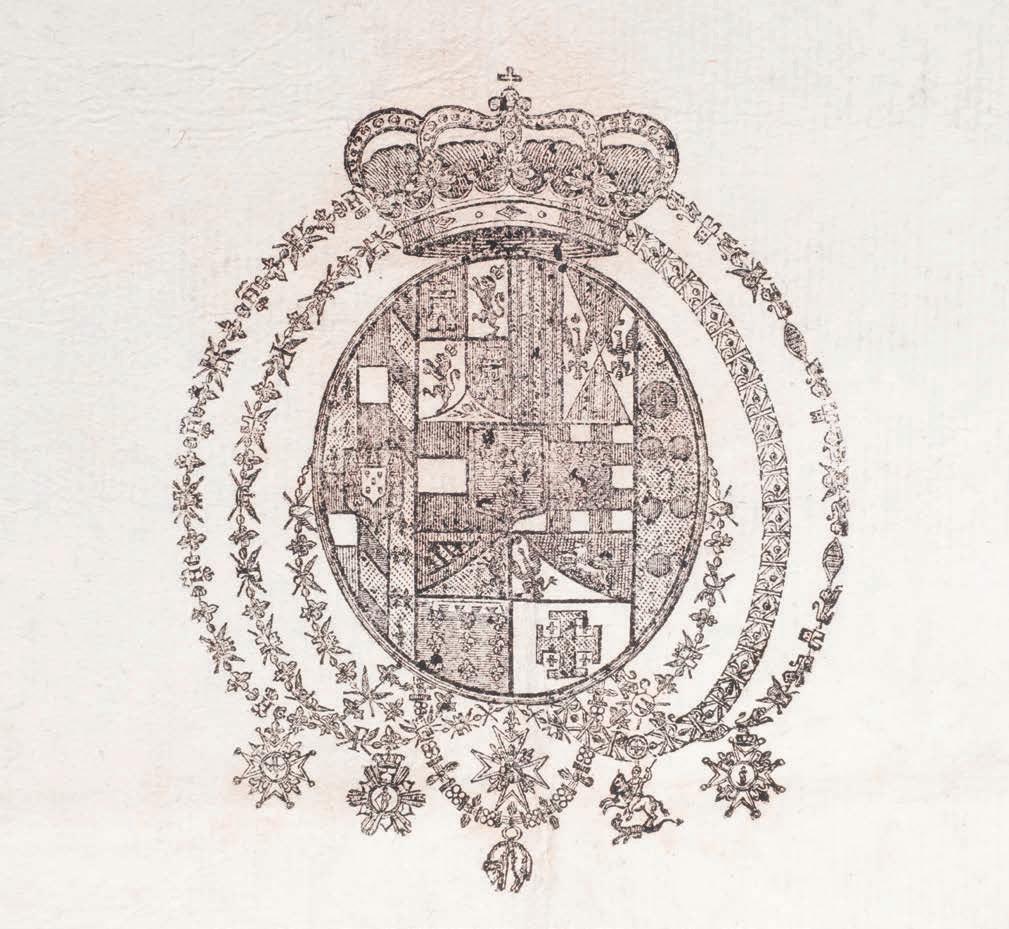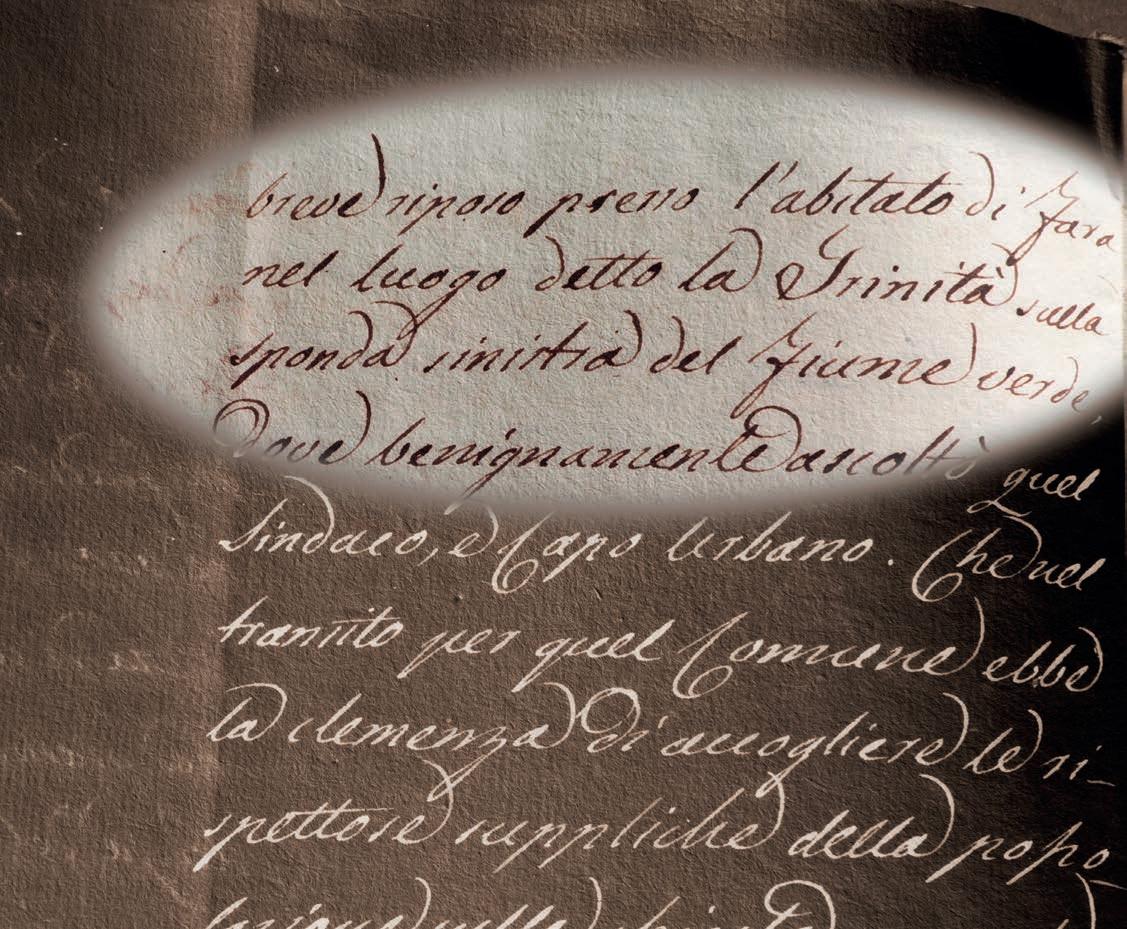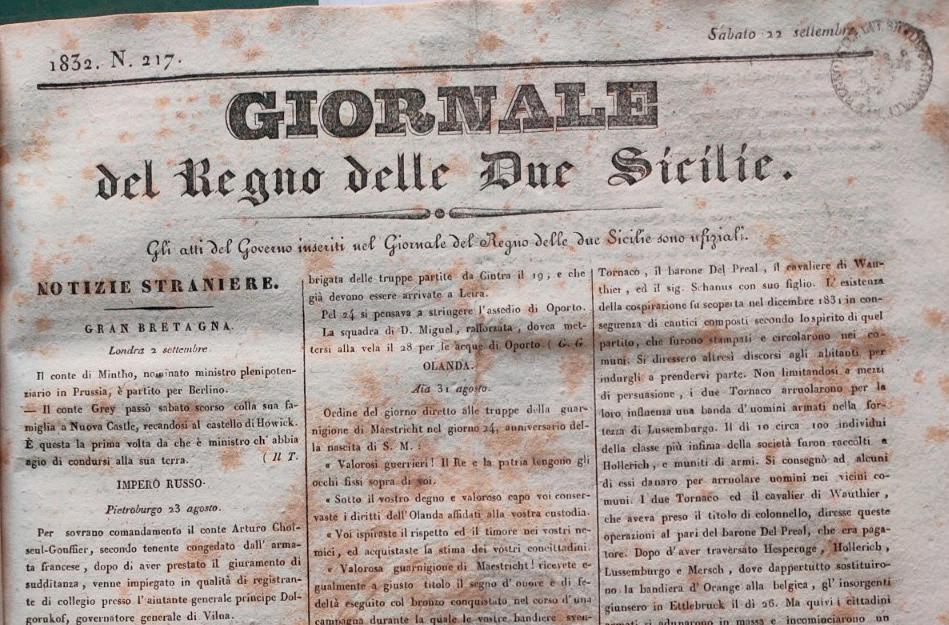
8 minute read
The De Cecco 130 years stamp on show in Bratislava thanks to the Rapisarda collection A.d. 1832, sua maestà Ferdinando II attraversò l’Abruzzo Citra e fece una sosta a Fara San Martino
A.d. 1832, sua maestà Ferdinando II attraversò l’Abruzzo Citra e fece una sosta a Fara San Martino
In 1832, His Majesty Ferdinand II crossed Abruzzo Citra and stopped off at Fara San Martino
Advertisement
Sandro Sciarra
Sul Giornale del Regno delle Due Sicilie datato 22 settembre 1832 si riporta, nello spazio dedicato alle notizie interne, un articolo titolato “Il viaggio di S. M. il re N. S. in Molise e nei Distretti di Vasto e Lanciano”. All’epoca il Sovrano era Ferdinando II, poco più che ventenne, salito al trono nel 1830. Il viaggio, cominciato con la partenza da Napoli Capitale il 12 settembre, vede l’arrivo del giovanissimo monarca nella provincia di Abruzzo Citeriore, o Citra, soltanto due giorni dopo. L’Abruzzo Citra era costituito dai distretti di Vasto, di Lanciano e di Chieti; quest’ultima città era anche il capoluogo di provincia. Il giorno 16, domenica, S.M. il Re è nel distretto di Lanciano che comprendeva la fascia di territorio che andava da Torino di Sangro sulla costa a Palena nell’entroterra.
Sul giornale, a metà articolo, si legge:
“[…] La mattina del 17, S. M. alle sette partì da Lanciano tra nuovi ed oltremodo vivi festeggiamenti della popolazione, dirigendosi a Palena. Gli abitanti di Castelnuovo, di S. Eusanio e di Casoli si trovarono sul passaggio per renderle i loro omaggi affettuosi.
Nel luogo detto Fiume Verde, e propriamente nella pianura nominata Fara S. Martino sotto la Majella, S. M. volle fermarsi qualche ora per riposare. Ripigliò poscia il viaggio, accompagnata dal Segretario Generale dell’Intendenza di quella Provincia stessa.
La popolazione de’ piccoli comuni di Civitella, di Lama e di Taranta festeggiarono con sommo tripudio il passaggio del Monarca. La strada da Lanciano a Palena era in assai cattiva condizione. La M. S. pervenne in Palena alle 5, p. m., ove una Deputazione colle Autorità del luogo attendevala sul ponte […]”.
Per individuare il luogo preciso relativamente al desiderio di Sua Maestà Ferdinando II di riposare durante quel viaggio sono esaustive le indicazioni riporIn the Newspaper of the Kingdom of Two Sicilies dated 22nd September 1832, an article can be found in the internal news section, entitled “His Majesty the king’s trip N.S. to Molise and the Vasto and Lanciano districts”. At that time, the ruler was the young twenty year old Ferdinand II, who climbed to the throne in 1830. The trip began from the capital Naples on 12th September with his arrival coming only two days later in the province of Abruzzo Citeriore or Citra. Abruzzo Citra was made up of the towns of Vasto, Lanciano and Chieti; the latter was also the main town of the province. On Sunday 16th, His Majesty the king was in Lanciano, a strip of land that went from Torino di Sangro on the coast to the inland town of Palena.
Halfway through the newspaper article, it is possible to read:
“[...] The morning of the 17th, His Majesty left Lanciano at 7 o’clock among the new and exceedingly lively celebrations of the people and headed towards Palena. The inhabitants of Castelnuovo, S. Eusanio and Casoli found themselves on the route to pay their affectionate respects to him.
In Fiume Verde, or more appropriately, the lowland called Fara S. Martino under the Majella, His Majesty wanted to stop and have a break for a few hours. He then restarted his trip accompanied by the Secretary General of the Intendancy of that province.
The population of the small villages of Civitella, Lama and Taranta celebrated the passage of the monarch with huge triumph. The road from Lanciano to Palena was in pretty poor condition. The Sovereign Majesty reached Palena at 5p.m. where a deputation of local authorities were awaiting for him on the bridge [...]”. In order to identify the precise location relating to His Majesty’s desire to rest during that
IL SOVRANO DEL REGNO DELLE DUE SICILIE ACCOMPAGNATO DAGLI AIUTANTI DI CORTE E DAI MILITARI DI SCORTA SI FERMÒ DOVE ADESSO C’È IL MOSAICO DELLA DE CECCO THE SOVEREIGN OF THE KINGDOM OF THE TWO SICILIES ACCOMPANIED BY COURT AIDES AND MILITARY STOPPED WHERE THE MOSAIC OF DE CECCO CAN BE FOUND NOW
LO STEMMA DEL REGNO DELLE DUE SICILIE TRATTO DA UN DOCUMENTO CUSTODITO NELL’ARCHIVIO DI STATO DI CHIETI NELLE PAGINE SUCCESSIVE, UNO STRALCIO DEL RESOCONTO REDATTO DAL SOTTOINTENDENTE DEL DISTRETTO DI LANCIANO IL 22 NOVEMBRE 1832 IN CUI SI PARLA DI FARA SAN MARTINO E LA TESTATA DEL GIORNALE DEL REGNO DELLE DUE SICILIE THE COAT OF ARMS OF THE KINGDOM OF THE TWO SICILIES TAKEN FROM A DOCUMENT KEPT IN THE STATE ARCHIVE OF CHIETI IN THE FOLLOWING PAGES, AN EXCERPT OF THE REPORT DRAWN UP BY THE DISTRICT SUPERINTENDENT OF LANCIANO ON NOVEMBER 22, 1832 IN WHICH HE TALKS ABOUT FARA SAN MARTINO AND THE HEAD OF THE NEWSPAPER OF THE KINGDOM OF THE TWO SICILIES.

tate sul giornale, previa dovute considerazioni. Quella sosta necessitava di uno spazio con una estensione tale da poter contenere una gran folla, costituita dagli aiutanti di corte, dai militari della guardia e dalla popolazione residente, oltre a centinaia di cavalli e carri di vario tipo. A Fara San Martino vi è una sola pianura così grande compresa tra le falde della Maiella e la riva sinistra del fiume Verde. Si può quindi affermare che essa è la stessa dove, a partire dagli anni ’70 del secolo scorso, è stato realizzato il complesso produttivo del Molino e Pastificio F.lli De Cecco di Filippo.
Del resto, il citato articolo di giornale è sia una fonte dalla quale attingere notizie del fatto accaduto sia un punto di partenza per una nuova ricerca di approfondimento. Infatti, gli storici sanno che di uno stesso evento si può trovare più di una traccia, specialmente se riguardano l’Amministrazione di uno Stato o di un Regno. Nel 1832 il Segretario Generale dell’Intendenza, relativamente alle res gestae citate, journey, the indications given in the newspaper were exhaustive and subjected to due considerations. The stop required a space with such a large extension so as to contain a large crowd made up of court aides, military guards and residents as well as hundreds of horses and various types of carts. There is only one plain in Fara San Martino that is large enough and it is located between the slopes of Majella and the left bank of the Fiume Verde. It can be said that it is the same place where the productive complex of Molina and the De Cecco di Filippo pasta factory was built in the 70’s of the previous century.
Moreover, the aforementioned newspaper article is both a source from where news of the event can be obtained and a starting point for new in-depth research. As a matter of fact, historians know that more evidence can be found of the same event especially since we are talking about the administration of a state or a kingdom. In 1832, the Secretary General
produsse della documentazione divenuta oggi consultabile presso l’Archivio di Stato di Chieti nella quale emerge un altro importante elemento:
“[…] S. M. si degnò fare un breve riposo presso l’abitato di Fara nel luogo detto la Trinità sulla sponda sinistra del fiume Verde, dove benignamente ascoltò quel Sindaco e Capo Urbano. Che nel transito per quel Comune ebbe la clemenza di accogliere le rispettose suppliche della popolazione sulla chiesta grazia di elevarsi Fara a Capoluogo di Circondario. Che la bontà con la quale furono pronunciate le sovrane parole di voler dare a quella pendenza la più sollecita e giusta risoluzione ha abbandonato quelli abitanti alla pubblica gioja, ed all’entusiasmo di eternare la memoria di essersi l’augusto Monarca soffermato in quel luogo coll’erigervi quando prima un monumento analogo, come hanno solennemente promesso […]”.
Questa testimonianza insieme alla precedente ci permette di individuare, con uno scarso margine di errore, il luogo esatto dove il re Ferdinando II si fermò in quel dì 17 settembre 1832. Sulla riva sinistra del fiume Verde esiste ancora oggi il riferimento della cappellina votiva dedicata alla Santissima Trinità come riportato nel documento d’archivio. Là dove si era solennemente promesso di erigervi un monumento alla memoria della sovrana maestà vi si trova oggi un mirabile mosaico la cui immagine è divenuta l’emblema dell’attività della De Cecco … un augusto monumento alla pasta di qualità! S of the Intendancy, in relation to the mentioned res gestae, produced a document that is available through the state archives of Chieti and where another important element emerges: “[...] His Majesty deigned himself to take a short break at the inhabited area of Fara known as Trinità on the left bank of the Fiume Verde, where he graciously listened to the Mayor and the urban chief. During the transit towards that municipality, he had the clemency to receive the respectful supplications of the population to elevate Fara to Capital of the district. The kindness that the sovereign words pronounced in promising to give the slope the most prompt and just resolution gave those inhabitants public joy as well as the enthusiasm to eternalize the memory of having the monarch in that location [...]”.
This testimony together with the previous one allows us to identify, with a small margin of error, the exact location where king Ferdinand II stopped on that day on 17th September 1832. On the left bank of the Fiume Verde, there is the reference to the votive church dedicated to the Holy Trinity as shown in the archive document. In the exact location where the promise of erecting a monument in memory of the Sovereign Majesty was made, stands an admirable mosaic whose image has become the emblem of De Cecco’s business… a monument to quality pasta! S











